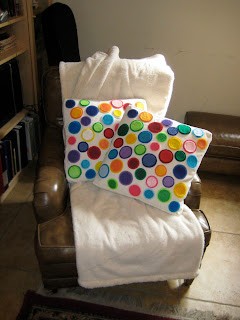Tips for Cutting Felt
This week I made some cheerful felt pillows with felt circles and decided to share some tips for cutting felt.
Washable markers work well for tracing patterns onto felt. (First, dip a small corner of the felt in water to make sure it wouldn't bleed. Mine didn't.) They rinse off very easily with water. I used to use permanent markers, which caused me to spend much time cutting off the marked parts. And then I tried pinning the pattern to the felt, but the pattern inevitably moved around while I was cutting, causing very uneven shapes. Finally I discovered the washable marker. Unlike quilting pens, they are very inexpensive ($2.00 for 8 compared to $6.00 for 1), and versatile. And I don't have to worry about my little one coloring on stuff as much.

Here it is, traced onto the felt.

There are almost always jagged edges on felt cut-outs. It helps with the overall appearance to trim off jagged and uneven parts.

Much better.

Then I rinse off the washable marker in a bowl of water and squeeze dry with a paper towel.


































